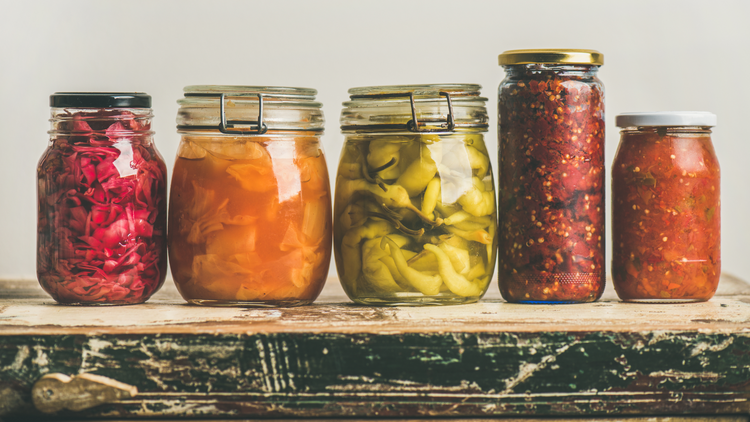September 26, 2022

Save Summer: Canning Food
Signs of a new season are all around. The colors are changing, the leaves are falling, and the temperature is chilling out a bit.
With the change of seasons also comes a change in nature’s bounty. New fruits and veggies start to line the shelves of your local grocery stores and farmer’s markets. But summer brings an abundance of tasty treats. If you’ve got a kitchen full of green beans, tomatoes, cucumbers and berries, try canning to preserve them and avoid waste.
What is canning? Well it’s a way of saving food to extend it’s shelf life. The items are processed and sealed in an airtight container, like a mason jar or tin can, and then ready store for use later.
Why use canning for food preservation?
Maybe it’s nostalgic. Have you ever opened up a jar of fruit preserves and been reminded of a Sunday morning breakfast at your grandmother’s? Or maybe a few pickled green beans used to be your favorite childhood snacks.
Save money and avoid food waste. Home food preservation is a great way to save food when you have more than you can use at once.
Canning is a great tool to do this. It also saves money, especially if you grow your own food. Keep them handy or give them away to friends and family. Who doesn’t love a good batch of homemade jam?!
Stock your pantry. Canning makes it easy to give fruits and veggies a longer shelf life, so you have plenty of time to enjoy them. It also makes them much more versatile.
Cucumbers become pickles and relish. Most fruits can be cooked down to a delicious jelly or jam. And fresh tomatoes are great for making homemade stews and tomato sauces!
Healthy food options. By canning food yourself, you know exactly what’s in it. A lot of store bought items have extra filler ingredients to help preserve the food. This way you can make your own staples without having to worry what else is being added to your family’s diet.
Types of Food Canning
There are two main methods for canning – water bath canning or pressure canning. Once you know a little about how each one works, you can use the one that fits for your food items.
Water bath canning is a lower-temperature canning process. This one is really good for high acid foods. The longer cook time paired with the lower temperature helps destroy mold, yeast and enzymes that cause food to spoil. Use this method for things like:
· Tomatoes and Salsas
· Pickles and Relishes
· Fruits, Jams and Jellies
· Sauces and Pie Fillings
· Vinegars and Condiments
Pressure canning is a higher temperature method. Bring the water to a temperature of 240 degrees F which will safely preserve low acidity foods. This temperature along with the amount of time cooking will destroy bacteria and prevent spoilage. Use this method for things like:
· Vegetables
· Salsas
· Meats, Poultry and Seafood
How to Can Food
Now that you know about each of the canning methods, it’s time to get started on your home food preservation! First, what do you need?

Canning Supplies:
· Water Bath Canner
· Pressure Canner
· Mason Jars
· Jar Lids and Rings (for reusing jars)
· Jar Grabber (for picking up your jar out of the canner)
· Citric Acid or True Lemon Wedges
· Large Pot
Pro Tip: Not everyone has citric acid lying around the kitchen, so lemon juice is a popular replacement. Use one tablespoon of lemon juice for every ¼ teaspoon citric acid called for. Use True Lemon to avoid even more prep and waste. Two packets are equal to one tablespoon of lemon juice.

Basic Canning Steps:
1. Choose the canning recipes that you’d like to try. There are lots of recipes that are great for beginners.
2. Gather all your canning supplies and the foods that you will be using.
3. Clean and sanitize your jars well before using them. Be thorough because this will ensure your food does not spoil.
4. Prep your canning food according to the recipe you’ve chosen.
5. Process your items according to your chosen method and processing times.
6. Remove the canning jars and let sit to cool and seal. Avoid getting food on the jar lid because this will prevent the jar from sealing properly. (After 12-24 hours check the top center of the lid to see if it has any give. If it does, it did not seal properly and you should move that one to the fridge for immediate use.)
7. Store your jars in a cool dry place, such as a pantry, and use within 1-2 years or according to the recipe shelf life.
How Does Canning Work?
OK, so how does this work exactly? Well, a few things to know about canning… you are heating up the food in the jar for long periods of time to kill off any bacteria that would eventually cause it to spoil.
When canning is done correctly, air is driven out. This is why you must leave head space at the top of the jar when filling it. It’s usually about half an inch of space between the top of the food and the top of the jar, but double check if your recipe calls for more room.
When air is driven out of the jar, it causes a vacuum seal on the lid. This is when you should hear a popping sound, notating that the lid has sealed. When there is no air and no bacterial microbes, the product is then preserved and ready to store with a longer shelf life.
We recommend water bath canning to get started. This method is great for beginners. Pressure canning is a little more advanced and requires more time and equipment.
Learn more about home food preservation.
Learn more about preserving and canning food, including detail steps from these great additional resources:
Bless This Mess – How To Can Food: Learn the Basics
National Center for Home Food Preservation
Lively Table – Beginner’s Guide to Canning
The Spruce Eats – How To Process Foods in a Water Bath Canner

Written by
Amy Cimo is a Nutrition Coach, Personal Trainer and Wellness Enthusiast based out of Baton Rouge, Louisiana. After going through her own health journey, she found her passion in helping others find balance between nutrition, physical activity and mindset to live healthy and be truly happy. Amy attended Louisiana State University where she received a Bachelor of Arts in Mass Communication and a Bachelor of Science in Business Administration. She became a Certified Personal Trainer in 2021 through the National Academy of Sports Medicine (NASM) and a Certified Nutrition Coach in 2022 through Precision Nutrition.
More on Health and Wellness







